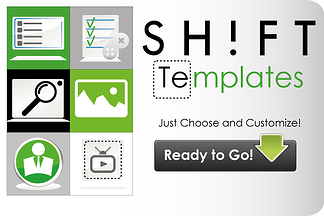SHIFT offers you over 250 different types of screens, in different categories in order to meet different needs and achieve different learning objectives. Therefore, by using these smart templates it doesn’t mean anymore that every screen has to look identical. Instead, you can provide lots of variety and creativity to your courses.
If you have the right authoring tool, creating killer eLearning courses can become less painful. Starting by the fact you don't have to look for inspiration or start a course from scratch anymore. These smart templates allow developers to just choose the best interaction for the content they have. It’s as easy as clicking on a thumbnail. By filling in the preconfigured fields, the development environment will know what needs to be displayed on screen, what needs to be recorded, what needs to be uploaded as images, video and even waht buttons to include.
Try the following types of screens the next time you sit down to create an eLearning course.
 Types of screens:
Types of screens:
- Informative: Present content in a diffent way. Organize content in bullets, sticky notes, boards, process or the steps of a procedure, or even transform it into a time line,
- Learning Agents: Support content with avatars or characters, use them as a course’s tutor and guide students along the course. You may want to add a board as well.
- Explorative: Use these screens to present case studies or success stories, show a cycle, or explain the different parts of a specific product or thing.
- Evaluation: Create a unique look and feel for your practice and evaluation screens.
- External Resources: You may want a special screen for videos, SHIFT has it. Embed videos from YouTube or upload them from own computer.
- Simulations: Use the scenario builder to present real life situations, characters can interact with each other, simulate real life situations of your company.
These templates are developed taking into account various elements that result in additional benefits such as:
- Integrating best practices of usability and effectiveness for learning: Unlike other learning resources that are customized, these templates are tested for effectiveness and usability before being released.
- Extensive technical tests: Before releasing a template, it’s tested on different platforms, under different conditions, in a matter that the chances of failure are reduced.
- Continuous improvement and "updates": The templates are improved continuously, based on new technological requirements, user requirements and instructional strategies.
Using templates will definitely allow you to:
- Focus on what’s important (creating new ways to make the course more interesting and effective). Don’t keep wasting time thinking how to design a screen or where to place the images and buttons. We know all you want to think about is of effective content.
- Develop more courses in a short period of time. Develop courses to keep pace with the market demands.
- Create a highly interactive, rich media experience for the user withour needing to program anything. With SHIFT the user can create the experience of a rich media course with the person-hours involved in development of a rapid development tool.








